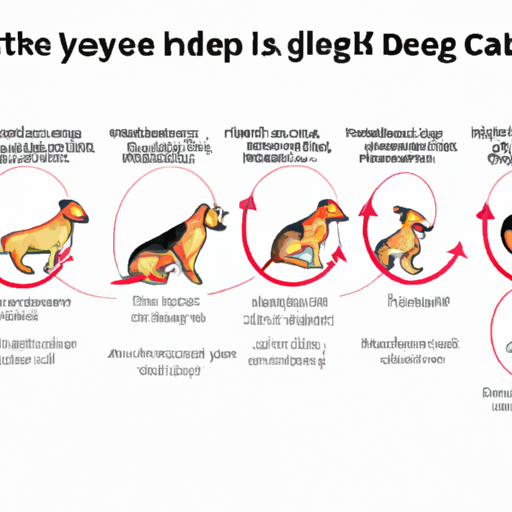As a dog caregiver, it’s important to understand the various stages of your dog’s reproductive cycle, particularly if you’re considering breeding. One phenomenon that can often cause confusion is split heat in dogs. Split heat is a condition where a dog goes into heat but does not complete the cycle, only to resume it after a short period. Understanding this condition is key to maintaining the health and well-being of your furry friend.
Table of Contents
- Understanding Heat Cycles in Dogs
- What Is Split Heat?
- Causes of Split Heat
- Symptoms and Detection
- Effects on Breeding
- How to Manage Split Heat
- Prevention and Treatment
- Frequently Asked Questions
Key Takeaways
- Split heat is a break or interruption in a dog’s heat cycle.
- It’s more common in young dogs experiencing their first few heat cycles.
- Split heat can affect breeding plans and the health of your dog.
- Regular vet check-ups can help detect and manage split heat.
Understanding Heat Cycles in Dogs
Before delving into split heat, it’s helpful to understand a dog’s heat cycle. The heat, or estrous cycle, is the period when a female dog is receptive to breeding. This cycle occurs roughly every six months and is divided into four stages: proestrus, estrus, diestrus, and anestrus.
During the proestrus stage, your dog may exhibit signs of being in heat, but isn’t ready to mate yet. The estrus stage is when she’s receptive to males, and this is the period when breeding usually occurs. After estrus, the diestrus stage starts, followed by the anestrus stage, where the dog’s body rests for the next cycle.
What Is Split Heat?
Split heat occurs when a dog goes into the proestrus stage, but instead of progressing to the estrus stage, the cycle abruptly stops. After a short period, usually a couple of weeks to a month, the dog resumes the heat cycle, entering the estrus stage. This interruption can create confusion, especially if you’re planning to breed your dog.
Causes of Split Heat
Split heat is more common in young dogs experiencing their first few heat cycles. It’s believed to be a result of the dog’s body still adjusting to hormonal changes. Other factors can also contribute to split heat, such as stress, underlying medical conditions, or changes in the dog’s environment. It’s recommended to consult with a vet if you suspect your dog is experiencing split heat to identify any potential issues.
Symptoms and Detection
Detecting split heat can be challenging, as the symptoms during the interruption period can be subtle. Some dogs may exhibit signs such as reduced appetite, lethargy, or changes in behavior. However, these symptoms can also be associated with other health issues, hence the importance of regular vet check-ups.
The most definitive way to detect split heat is through hormone testing. Vets can measure the levels of hormones like progesterone and estrogen in your dog’s blood to confirm if she’s experiencing split heat.
Effects on Breeding
Split heat can have direct implications on your breeding plans. If you’re planning to breed your dog during a specific heat cycle, the interruption can push back the timing. It’s also possible for a dog to get pregnant during the first part of split heat, but the chances are significantly lower than during a regular cycle.
How to Manage Split Heat
If your dog is experiencing split heat, it’s crucial to keep a close eye on her behavior and health. Regular vet visits can help monitor her condition and ensure she’s healthy. It’s also essential to adjust your breeding plans accordingly if you’re intending to breed your dog.
Prevention and Treatment
Currently, there’s no specific treatment for split heat, as it’s not considered a disease but rather a natural occurrence in some dogs. However, maintaining a healthy lifestyle for your dog, including regular exercise and a balanced diet, can help reduce the chances of split heat. Regular vet check-ups can also help detect any underlying conditions that might contribute to split heat.
Frequently Asked Questions
Q: Can split heat harm my dog?
A: Generally, split heat is not harmful to dogs. However, it’s important to monitor your dog’s health and consult with a vet if you notice any unusual behavior or symptoms.
Q: Can my dog get pregnant during split heat?
A: While it’s possible for a dog to get pregnant during the first part of split heat, the chances are significantly lower than during a regular heat cycle.
Q: How can I prevent split heat in my dog?
A: Maintaining a healthy lifestyle for your dog, including regular exercise and a balanced diet, can help reduce the chances of split heat. Regular vet check-ups can also help detect any underlying conditions that might contribute to split heat.
To better understand dogs’ reproductive cycles, check out these informative articles from OneTopDog. You can learn about the Importance of Regular Vet Check-Ups, Understanding Dog Breeding, and How to Maintain Your Dog’s Health.
For more in-depth information on canine reproduction, this article from VCA Hospitals provides a comprehensive overview. As always, regular consultation with your vet is crucial in managing your dog’s reproductive health.



